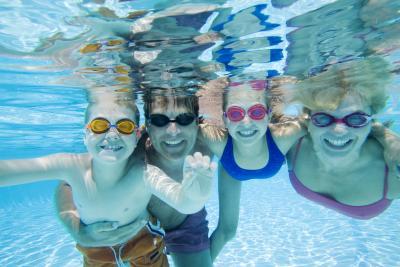
This article originally appeared in LiveHealthy.Chron.com
Home swimming pools provide an easily accessed workout option in the United States, with 10.4 million residential swimming pools in the United States in 2011, according to the Centers for Disease Control and Prevention. Depending on the size and depth of your swimming pool, you have a multitude of options for incorporating aquatic exercise into your regimen. Lap swimming provides an excellent workout, but if your pool is small you can still burn calories, improve your endurance, and boost your strength with other water exercises.
Aqua Aerobics for Cardiovascular Health
Get a great full-body workout in a small space with water aerobics. Water resists movement in every direction because it surrounds your body, adding constant challenge. Increase the difficulty of your work out by changing your level of exertion — increase the speed of the movement, use the large muscles in your arms and legs, make your movements bigger by straightening your limbs, increase your range of motion or add drag by cupping your hands, flexing your feet or adding equipment such as paddles. To improve your cardiovascular health, exercise at least a total of 150 minutes per week, exerting yourself at a level that increases your breathing and heart rate. Exercises that use both your arms and legs, such as water walking and running with underwater arm pumps, jumping jacks, cross country skiing movements and side leaps help you achieve this intensity.
Aquatic Strength Training
If your goal is strength training and you own a pool, you’re in luck. Because water is 1000 times more resistant than air, drag greatly increases the load on your muscles. While the goal of swimming is to increase speed by minimizing resistance, the goal of strength training in water is to increase resistance through drag. When you push through water, the water resists with an equal amount of energy. This natural resistance strengthens and tones your muscle pairs equally and efficiently. You can use the same exercises for strength training that you use for cardiovascular training or focus on one body part at a time. To improve strength, move at or near maximum effort so your muscles fatigue after 15 repetitions. Add the equivalent of water dumbbells to add greater resistance, though you can start with cupped hands or simple paddles.
Aquatic Relaxation
According to a study published in the January 2010 “International Journal of Sports Medicine,” the hydrostatic properties of water may decrease inflammation. Fluid range-of-motion exercises further decrease muscular tension and increase relaxation. Benefit from the relaxing and releasing qualities of water when you take advantage of water’s buoyancy. Float on your back and move your arms and legs gently. Balance in a floating plank with a pool noodle supporting you, tuck your knees in to your chest then extend them behind you. Float on a pool noodle and swing your legs side to side and in circles to release your hips, torso, and legs. If you prefer to keep a foot on the floor, simply move your arms and one leg through a circular, fluid range of motion for an added balance challenge.
Remember Safety Basics for Water Workouts
Always follow water safety rules: Don’t swim alone and make sure you have safety equipment, such as flotation rings and rescue poles, poolside. If something hurts, don’t do it. Because of its buoyancy, water allows you to move through a greater range of motion: Don’t overextend your joints. If a movement is difficult, decrease resistance. For the least resistance on your arms, bend your elbows and slice your hands through the water or make a fist with your hand. To decrease resistance on your legs, bend your knees.
References (4)
Photo Credits
- Polka Dot Images/Polka Dot/Getty Images



